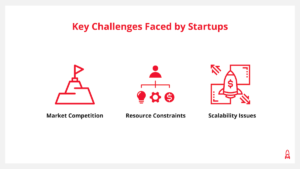According to the Global Entrepreneurship Monitor (GEM), an estimated 305 million startups are created every year. To put this in context, that is over 25 million new startups every month. Singapore is home to approximately 4,500 tech startups, and continues to dominate the startup landscape in the region. Last year, the city-state accounted for 56% of total deal volume recorded in six of the largest economies in the region and 64% of the total deal value.
Several key advantages, such as supportive government policy and a vibrant venture capital scene might suggest that the new ventures can grow and innovate without the overwhelming pressure found in saturated markets. The reality however is more complex; despite Singapore having a flourishing startup scene, resource constraints, market access, complex regulations – just to name a few – hinder the growth of many promising startups. Open Innovation is positioned to address many of these challenges, unlocking new pathways to success.
Startup Challenges

Startups often operate in conditions filled with uncertainties. Each step towards growth introduces new challenges that vary depending on the vision of the founders, the nature of the business and the market landscape. Some of the common challenges that startups often face include market competition, a shortage of key resources as well scalability issues.
1. Market Competition
In today’s competitive startup landscape, startups find themselves grappling with the formidable challenge of distinguishing themselves not just from fellow startups, but also from well-established competitors. Winning customers away, especially from the more established companies, is difficult given the years these companies have spent building loyalty.
In addition to this, the relentless pace of technological advancement, from established competitors and new ventures, mandates that existing startups continually evolve and adapt, lest they find themselves at risk of becoming obsolete.
2. Resource Constraints
Resource constraints represent another key challenge confronting both new and existing startups. A 2022 Position Paper by the Action Community for Entrepreneurship (ACE) and PwC highlighted that talent shortages, funding limitations, and restricted market access are contributing factors to the stagnation, plateaus, and even the closure of startups with high-value, unicorn potential.
The scarcity of such resources can have a ripple effect, impacting other essential departments, such as customer service or quality assurance, thereby affecting overall business quality.
3. Scalability Issues
As with any growing business, increased demand often calls for stronger infrastructure, whether that’s more server capacity or better logistical support. Additionally, scaling up usually introduces its own set of challenges, like maintaining quality control and balancing higher production against operational costs. If not managed carefully, these issues can negatively impact a startup’s reputation or even lead to its downfall.
Open Innovation Explained
The concept of Open Innovation was first introduced by Professor Henry Chesbrough in his 2003 book, Open Innovation: The New Imperative for Creating and Profiting from Technology. It outlines a model where organisations actively seek and incorporate external ideas and resources to fuel their innovation and growth.
Traditionally, the realms of business development and marketing were largely confined within the walls of the organisation. However, the rise in the number of highly educated individuals has led to a significant body of knowledge existing beyond the laboratories of large corporations. Alongside this, the growth of venture capital funding has enabled the development of innovative ideas and technologies outside these corporations, often through startups that are venture-backed.
By tapping into technologies and ideas that originate externally, and by collaborating with suppliers and even competitors, companies can enhance both the effectiveness and efficiency of their innovation processes. This, in turn, allows them to create products, technologies, and services that offer greater value.
Benefits of Open Innovation
Against the backdrop of knowledge spillover, escalating costs associated with innovation, and the ever-present scarcity of resources, Open Innovation emerges as a transformative approach. It is poised to redefine how startups can discover new avenues for growth and expedite their time-to-market. Below are some of the key ways to overcome startup challenges with open innovation.
1. Accelerated Time to Market
Open innovation can help startups accelerate time-to-market. Through collaborative efforts, startups can quickly access ready-made solutions, share the burden of R&D costs, and pool collective knowledge, resources and expertise to solve problems more efficiently.
Furthermore, by partnering with more established industry players—particularly those pre-existing infrastructure and customer bases—startups can streamline prototyping and marketing. Such collaborations also provide an immediate route to market through established distribution channels.
2. Reduced R&D Costs
Startups often operate under tight budgets. By partnering with larger enterprises, for example, they can share costs and leverage expertise and resources to reduce the financial burden of innovation. In doing so, they can optimise R&D expenditure, and allocate capital more efficiently across other business areas—be it marketing or scaling operations.
3. Market Positioning
In addition to lowering R&D expenditures, Open Innovation offers another advantage through the lens of product differentiation. It enables both startups and their more mature corporate partners to enhance their market positioning. Collaborative projects that result in unique value propositions set them apart from the competition, and this can be especially beneficial to startups looking to carve out a niche or gain market traction.
4. Risk Sharing
Both startups and mature companies face considerable financial and operation risks when pursuing new innovations. By engaging in open innovation, these risks can be more evenly distributed between the involved parties. For instance, collaborative development efforts can mitigate the risk of being outpaced by competitors, potentially allowing the partnership to be the first to bring a new solution to market.
Sharing resources, whether financial, technological or otherwise, not only reduces the financial burden to any single entity, but can also contribute to the development of more robust solutions. This is especially beneficial to startups as it allows them to engage in R&D activities that would be too costly or risky to undertake alone.
5. Global Networks
Cross-border open innovation partnerships offer a pathway for partnering organisations to broaden their influence and market reach. For instance, startups that collaborate with international partners gain invaluable insights into diverse markets, enabling them to adapt their products or services to align with specific cultural norms.
Additionally, startups can more easily navigate the regulatory landscapes of the markets in which their partners are established. This can significantly reduce the time, cost, and effort required for understanding and achieving compliance, further streamlining their expansion efforts.
6. Opens the Door for Future Opportunities
For both startups and mature enterprises, open innovation can not only help address business challenges but also pave the way for future opportunities. Relationships and networks built through collaboration can yield long-term partnerships, ongoing access to essential technologies and the potential for future joint ventures or mergers.
Through Scaler8’s Cross-border Innovation program, Singapore-based startup Polymerize had the opportunity to pitch its solution to Meraxis. This collaboration resulted in a PoC agreement, allowing Polymerize to demonstrate the power of its AI platform.
Are You Ready to Grow?
By embracing open innovation, startups and established companies can gain a competitive edge, achieve more with less, and position themselves for immediate and long-term success. Since our launch, Scaler8 has sought to help new ventures gain a foothold on the global stage. We evaluate the target market, implement through preparation steps and craft effective marketing strategies.
Currently, Scaler8 is partnered with NEDGEX, the corporate venture arm of Germany’s NETZSCH Group. NETZSCH is a global leader in machinery and instrumentation with a focus on three core business areas: Pumps & Systems, Grinding & Dispersing, and Analyzing & Testing. NEDGEX is actively seeking Singapore-based early-stage startups (Pre-seed & Seed) that align with NETZSCH’s solutions and core business areas.
If you are a Singapore-based startup that fits the criteria, don’t miss this opportunity to collaborate with a world-class industry leader- apply here today.
Reach out to us to learn more about our Open Innovation Platform. If you wish to get expert guidance on how to accelerate international expansion, we can help. We’ve got a wide network of mentors and partners ready to help take your business to new heights.




